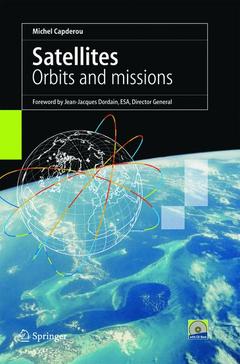Introduction Keplerian motion 1.1 Preamble 1.2 Acceleration 1.3 Central acceleration 1.4 Newtonian acceleration 1.5 Keplerian motion : trajectory and period 1.6 The three anomalies 1.7 Representation of the anomalies 1.8 Integrals of motion 1.9 Historical note on universal attraction 1.10 Annex : Ellipses Satellites on keplerian orbit 2.1 Gravitational field 2.2 The N-body and the two-body problem 2.3 Orbital parameters 2.4 Case of quasi-circular orbits 2.5 Keplerian period Satellites on real orbit (perturbed) 3.1 Perturbing forces 3.2 Terrestrial gravitational field (geopotential) 3.3 Perturbations and satellite altitude 3.4 Perturbation method : presentation 3.5 Perturbation method : resolving 3.6 Perturbation method applied to geopotential (J2 term) 3.7 Perturbation method applied to geopotential (general case) 3.8 Different definitions of the period 3.9 Notes on precession motion 3.10 Historical note on geodesy 3.11 Terrestrial geoid 3.12 Annex : Sphere of influence 3.13 Annex : Lagrangian points 3.14 Annex : Legendre's functions 3.15 Annex : Spherical trigonometry 3.16 Annex : Astronomical constants Orbit / Earth / Sun relative motion 4.1 Orbit motion 4.2 Earth motion 4.3 Apparent Sun motion 4.4 Geosynchronism 4.5 Sun-synchronism Orbit and track of the satellite 5.1 Satellite position on its orbit 5.2 Satellite track on circular orbits 5.3 Classification of satellite orbits 5.4 Classification of satellite missions 5.5 Annex : Satellite velocity on circular orbit 5.6 Annex : Duration of the satellite visibility 5.7 Annex : Notions of map projections Orbit relative to the Sun 6.1 Precession cycle 6.2 Overpass time for a Sun-synchronous satellite 6.3 Annex : Duration of the solar eclipse Orbit relative to the Earth 7.1 Constraints for the repeat cycle 7.2 Repeat cycle for a Sun-synchronous satellite 7.3 Repeat cycle for a LEO non-Sun-synchronous satellite 7.4 Repeat cycle for MEO and GEO satellites 7.5 Study of the track grid 7.6 Repeat cycle index 7.7 Variation of the altitude 7.8 Frozen orbit Views from the satellite 8.1 Swath of the instruments 8.2 Viewing geometry related to the swath 8.3 Pixel deformation 8.4 Swath track for a LEO satellite 8.5 View from a GEO satellite Temporal and angular sampling 9.1 Sampling strategy 9.2 Target-satellite direction 9.3 Target-Sun direction 9.4 Sun-target-satellite geometry 9.5 Monthly tables of sampling Satellite of Mars 10.1 Presentation of Planet Mars 10.2 Geodetical and astronomical data 10.3 Satellites on real orbits (perturbed) 10.4 Representation of the track 10.5 Orbits related to the Sun 10.6 Orbits related to Mars 10.7 Views from the satellite 10.8 Temporal and angular sampling 10.9 Annexes related to martian satellites Satellites of other celestial bodies 11.1 Planets of the Solar System 11.2 Geodetical and astronomical data (planets) 11.3 Satellites of planets on real orbits 11.4 Track of planet satellite 11.5 Natural moons of the Solar System 11.6 Geodetical and astronomical data (moons) 11.7 Satellites of natural moons on real orbits 11.8 Track of natural moon satellites Bibliography Index




